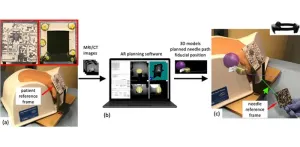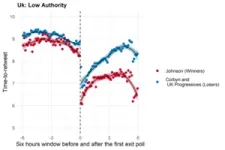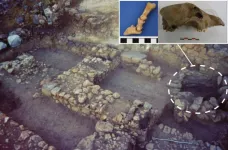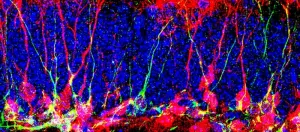(Press-News.org) According to the US Centers for Disease Control and Prevention, prostate cancer is the second leading cause of cancer death among men. One of the standard approaches for the diagnosis and treatment of prostate cancer involves transperineal (TP) biopsy. This involves inserting a needle through the perineum wall to collect tissue samples. Current methods for TP biopsy generally include a pre-operation MRI scan and a transrectal ultrasound. These images are then fused together and shown on a monitor to the urologist, who then inserts the needle. The needle insertion can be performed free-hand or through a grid-based method. However, since this approach involves visualizing a 3D region in 2D, visualization and guidance of the needle can be challenging.
To address this issue, a team of researchers led by Dr. Ming Li from the US National Institutes of Health have proposed an approach based on an augmented reality (AR) system called HoloLens. In their recent paper published in the Journal of Medical Imaging, the researchers report the accuracy and efficacy of their AR HoloLens system, which can be used to project the MRI and ultrasound image directly onto the patient, helping guide a needle to its target. According to Li, “The current methods have certain limitations to them. Robot-assisted guidance is costly and adds procedural time, while other methods require a certain path for the needle that leaves out the outer reaches of the prostate. These problems are solved using the HoloLens AR system, which provides the doctor with the ability to use a free-hand approach.”
The HoloLens AR system uses a volumetric 3D scan, such as an MRI scan, to create a view of the patient for the urologist. Using reference data from the patient, the MRI scan can be superimposed onto the patient correctly. This superimposed image is then fed into the HoloLens goggles worn by the urologist, who can see not only the patient but also the MRI of the patient, properly aligned. By moving their head, they can view the image at different angles. HoloLens can also be used to show a preplanned needle path on the patient, the target tissue of the prostate, and the position of the needle in real time.
The researchers tested the image overlay accuracy and needle targeting accuracy for their AR system using a 3D-printed phantom. Both free-hand and planned-path guidance methods were used to guide needles into a gel phantom. Following this, the researchers recorded the placement errors for the needles. Additionally, they also used the system to deliver soft tissue markers onto the tumors of a human pelvis phantom.
They found that the placement errors associated with free-hand and planned-path guidance were similar. Further, the soft tissue markers were all implanted either into or close to the tumors.
“The HoloLens has the potential to provide more flexibility than the current grid-based TP methods and can do so accurately,” highlights Li. “By providing a 3D immersive experience, the HoloLens AR system makes free-hand lesion targeting feasible. As needle procedures move from rectum to the perineum, AR systems could provide great clinical value to doctors and patients by solving the problems associated with prostate intervention procedures,” she concludes.
Read the Open Access article by Li et al., “HoloLens augmented reality system for transperineal free-hand prostate procedures,” J. Med. Imaging 10(2) 025001 (2023), doi 10.1117/1.JMI.10.2.025001.
END
Free-hand, real-time needle guidance for prostate cancer diagnosis with augmented reality
Researchers demonstrate a HoloLens AR system that enables accurate, flexible needle guidance for transperineal prostate interventions such as biopsy, focal laser ablation, and brachytherapy
2023-03-01
ELSE PRESS RELEASES FROM THIS DATE:
Special Selection
2023-03-01
A team of global experts has discovered new signals of natural selection in humans.
Led by UC Santa Barbara Tsimane Health and Life History Project co-director Michael Gurven, the team studied two populations living in the Bolivian Amazon rainforest — the Tsimane and the Moseten. Previous studies show that these tropical populations are exposed to many parasites and a variety of pathogens; at the same time, the Tsimane rarely suffer from cardiovascular diseases and dementia. This new research suggests that the Tsimane genome has undergone selection ...
Bronze Age well contents reveal the history of animal resources in Mycenae, Greece
2023-03-01
A large Bronze Age debris deposit in Mycenae, Greece provides important data for understanding the history of animal resources at the site, according to a study published March 1, 2023 in the open-access journal PLOS ONE by Jacqueline Meier of the University of North Florida and colleagues.
Animals were an important source of subsistence and symbolism at the Late Bronze Age site of Mycenae in Greece, as evidenced by their depictions in art and architecture, but more research is needed on the animals ...
What distinguishes fans from celebrity stalkers?
2023-03-01
A survey study of U.S. college students provides new insights into factors associated with the tendency to engage in celebrity stalking behaviors. Maria Wong (Idaho State University, U.S.), Lynn McCutcheon (North American Journal of Psychology, U.S.), Joshua Rodefer (Mercer University, U.S.) and Kenneth Carter (Emory University, U.S.) present these findings in the open-access journal PLOS ONE on March 1, 2023.
Celebrities around the world deal with the threat of unwanted and threatening or intimidating attention or harassment—commonly known as stalking. A growing body of research is exploring and identifying factors that are associated ...
Pregnant Shark birth tracking technology provides key data for species protection
2023-03-01
Most people find sharks threatening. Who doesn’t have an image in their mind of a menacing shark fin racing through the ocean in search of its next meal?
But it is the shark that is threatened.
According to Defenders of Wildlife, a national nonprofit dedicated to protecting imperiled species, 75% of shark species are threatened with extinction and up to 73 million sharks are being killed each year for their fins.
Habitats that were once secure places for sharks to give birth have also been affected. And the fact that sharks have long gestation periods, giving birth ...
Scientists discover how to prevent death of nerve cells in most common forms of MND and dementia
2023-03-01
**Strictly embargoed until 19:00 (GMT) Wednesday 1 March 2023**
Scientists discover how to prevent death of nerve cells in most common forms of MND and dementia
Researchers from the University of Sheffield’s Institute of Translational Neuroscience have discovered how to prevent the death of nerve cells and protect nerves from neurodegeneration in the most common forms of MND and frontotemporal dementia
The researchers used a peptide, a small assembly of amino acids or protein bricks, with a cell-penetrating ...
Obstacles for breast cancer prevention in high-risk Black women
2023-03-01
Black women at high risk of breast cancer face a variety of obstacles that may keep them from care that could prevent cancer and increase the chances they’ll survive if they develop the disease, new research has found.
A study from researchers at The Ohio State University provides insights into the factors that contribute to racial disparities in use of preventive measures, including genetic testing, prophylactic mastectomies and medication to thwart breast cancer.
In the new study, which appears today (March 1, 2023) in the journal PLOS ONE, the ...
Waxing and waning of environment influences hominin dispersals across ancient Iran
2023-03-01
A world-first model of paleoclimate and hydrology in Iran has highlighted favourable routes for Neanderthals and modern human expansions eastwards into Asia.
Published in PLOS ONE, the findings reveal for the first time that multiple humid periods in ancient Iran led to the expansions of human populations, opening dispersal route across the region, and the possible interactions of species such as Neanderthals and our own Homo sapiens.
Professor Michael Petraglia, a key researcher in the study, said historic humid ...
Vitamin B5 could help improve red blood cell production in people with Myelodysplastic syndromes
2023-03-01
Queen Mary University of London and Francis Crick Institute press release
Under strict embargo: 19:00hrs GMT Wednesday March 1, 2023
Peer reviewed
Experimental study
Cells
Vitamin B5 could help improve red blood cell production in people with Myelodysplastic syndromes
Scientists from Barts Cancer Institute at Queen Mary University of London and the Francis Crick Institute, have uncovered why patients with a rare type of blood cancer suffer from ineffective red blood cell production, and how vitamin B5 could be combined with existing drugs to improve outcomes.
Myelodysplastic syndromes (MDS) are a type of blood cancer characterised ...
How to generate new neurons in the brain
2023-03-01
Some areas of the adult brain contain quiescent, or dormant, neural stem cells that can potentially be reactivated to form new neurons. However, the transition from quiescence to proliferation is still poorly understood. A team led by scientists from the Universities of Geneva (UNIGE) and Lausanne (UNIL) has discovered the importance of cell metabolism in this process and identified how to wake up these neural stem cells and reactivate them. Biologists succeeded in increasing the number of new neurons in the brain of adult and ...
Stress gene dysregulation found in kids after injury from abuse vs. accident
2023-03-01
Epigenetic changes in the regulation of a key gene in the body’s stress response system were detected in babies and young children with abusive injuries, as opposed to accidental, according to a pilot study published in the journal Pediatric Research.
The epigenome influences levels of gene expression in response to the physical, social and emotional environment, without altering the DNA sequence. Multiple studies in adults have found that traumatic and adverse childhood experiences are associated with epigenetic alterations in the FKBP5 gene, an important regulator ...
LAST 30 PRESS RELEASES:
Scientists boost cell "powerhouses" to burn more calories
Automatic label checking: The missing step in making reliable medical AI
Low daily alcohol intake linked to 50% heightened mouth cancer risk in India
American Meteorological Society announces Rick Spinrad as 2026 President-Elect
Biomass-based carbon capture spotlighted in newly released global climate webinar recording
Illuminating invisible nano pollutants: advanced bioimaging tracks the full journey of emerging nanoscale contaminants in living systems
How does age affect recovery from spinal cord injury?
Novel AI tool offers prognosis for patients with head and neck cancer
Fathers’ microplastic exposure tied to their children’s metabolic problems
Research validates laboratory model for studying high-grade serous ovarian cancer
SIR 2026 delivers transformative breakthroughs in minimally invasive medicine to improve patient care
Stem Cell Reports most downloaded papers of 2025 highlight the breadth and impact of stem cell research
Oxford-led study estimates NHS spends around 3% of its primary and secondary care budget on the health impacts of heat and cold in England
A researcher’s long quest leads to a smart composite breakthrough
Urban wild bees act as “microbial sensors” of city health.
New study finds where you live affects recovery after a hip fracture
Forecasting the impact of fully automated vehicle adoption on US road traffic injuries
Alcohol-related hospitalizations from 2016 to 2022
Semaglutide and hospitalizations in patients with obesity and established cardiovascular disease
Researchers ‘listen in’ to embryo-mother interactions during implantation using a culture system replicating the womb lining
How changing your diet could help save the world
How to make AI truly scalable and reliable for real-time traffic assignment?
Beyond fragmented markets: A new framework for efficient and stable ride-pooling
Can shape priors make road perception more reliable for autonomous driving?
AI tracks nearly 100 years of aging research, revealing key trends and gaps
Innovative techniques enable Italy’s first imaging of individual trapped atoms
KIER successfully develops Korea-made “calibration thermoelectric module” for measuring thermoelectric device performance
Diversifying US Midwest farming for stability and resilience
Emphasizing immigrants’ deservingness shifts attitudes
Japanese eels, climate change, and river temperature
[Press-News.org] Free-hand, real-time needle guidance for prostate cancer diagnosis with augmented realityResearchers demonstrate a HoloLens AR system that enables accurate, flexible needle guidance for transperineal prostate interventions such as biopsy, focal laser ablation, and brachytherapy







